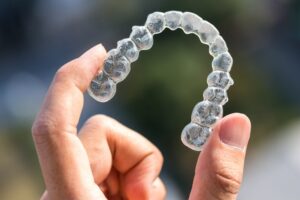
Starting clear aligner treatment, such as Invisalign, is exciting — you’re on your way to a straighter, healthier smile. However, it’s common to feel some discomfort during the first few days of wearing a new set of aligners. This mild soreness is actually a sign that your treatment is working, as your teeth are shifting into their new positions. Still, that doesn’t mean you have to just put up with it. With the right strategies, you can ease the adjustment period and stay comfortable.
Why New Aligners Cause Discomfort
Aligners work by applying gentle, continuous pressure to your teeth to guide them into alignment. When you switch to a new set, your teeth, gums, and jaw muscles need time to adapt to the updated pressure points. This can cause tenderness, tightness, or a mild aching sensation, especially in the first 48 hours after changing trays.
Tips to Reduce Aligner Discomfort
Switch Aligners at Night
One of the simplest ways to make the adjustment easier is to switch to your new set right before bedtime. This allows you to sleep through the first several hours, which are often the most uncomfortable. By the time you wake up, your teeth will have already started adapting to the new aligners.
Use Cold Compresses
If your mouth feels sore, applying a cold compress to the outside of your jaw can help reduce inflammation and numb discomfort. Use the compress for 10 to 15 minutes at a time, taking breaks in between.
Take Over-the-Counter Pain Relief (If Needed)
Mild pain relievers, such as ibuprofen or acetaminophen, can be helpful during the initial adjustment period. Always follow the dosage instructions on the label and consult your dentist or doctor if you have any concerns.
Keep Your Aligners In
It may be tempting to take your aligners out when your teeth feel sore, but wearing them consistently is key to easing discomfort faster. The more you wear them (at least 20 to 22 hours a day), the quicker your teeth adjust and the less pain you’ll feel.
Stick to Soft Foods
During the first day or two after switching aligners, choose softer foods like yogurt, scrambled eggs, pasta, and smoothies. This helps you avoid additional pressure on your teeth while they’re already adapting to the new trays.
Use Aligner Chewies
These small, soft cylinders are designed to help seat your aligners properly and improve fit. Biting on chewies for a few minutes a day can help your aligners work more efficiently while also massaging sore gums.
Practice Good Oral Hygiene
Clean aligners and a healthy mouth can help reduce irritation. Brush and floss regularly and rinse your aligners with lukewarm water — never hot, as heat can warp the trays.
When to Contact Your Dentist
Some tenderness is normal, but sharp or severe pain, sores that don’t heal, or aligners that feel unusually tight may indicate an issue. If you notice any of these signs, contact your dentist or orthodontist for guidance.
New aligners may bring a little discomfort, but with a few simple strategies, you can make the adjustment period much easier. Before you know it, each new set will feel like second nature and you’ll be one step closer to your dream smile.
About the Author
Dr. Gabrielle C. Dizon is a Dallas native and graduated from the Baylor College of Dentistry. She is committed to staying up-to-date with the latest developments in the dental field, maintaining membership in the Central Dallas Chapter of the Spear Education Study Club. Dr. Dizon also serves on committees with the Texas Dental Association and the American Dental Association and was voted by D Magazine as one of the best dentists in the city in 2020, 2021, and 2023. If you’re interested in Invisalign treatment, trust Dr. Dizon’s extensive training and experience for the best experience you can get! Schedule an appointment online or call our office at (214) 646-6202.
